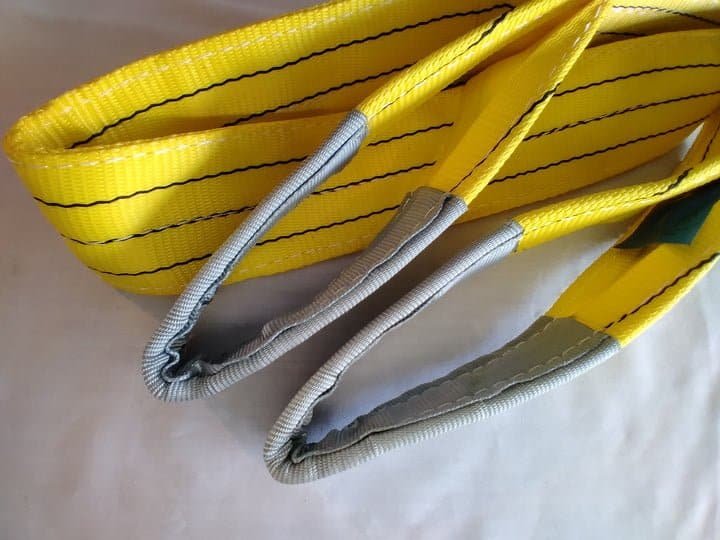In the Australian market, lifting slings are essential tools in hoisting and material handling operations, and their safety and performance must comply with strict national standards. Australia’s lifting sling standards primarily include AS 1353 and AS 4497, which apply to webbing slings (flat slings) and roundslings, respectively.
www.chinatoplifting.com
tracy@chinatoplifting.com
Overview of Applicable Standards
| Sling Type | Standard | Standard Title |
|---|---|---|
| Webbing Sling | AS 1353.1 / AS 1353.2 | Flat synthetic webbing slings – Manufacture & Use |
| Roundsling | AS 4497.1 / AS 4497.2 | Synthetic roundslings – Manufacture & Use |
Structure & Material Differences
Webbing Slings

- Structure: Made from one or more layers of woven polyester webbing. Common designs include flat type, eye type, and reinforced eye type.
- Features:
- Lightweight and flexible
- Easy to store and fold
- Wide contact area to avoid damage to loads
- Compatible with corner protectors for sharp-edged loads
Round slings

- Structure: Made of multiple high-strength polyester yarns as a load-bearing core, wrapped in a seamless tubular protective sleeve.
- Features:
- Endless loop construction enables omnidirectional loading
- Excellent flexibility, suitable for irregular or delicate objects
- Higher capacity range
- The damaged outer sleeve is visible for inspection
Safety Factor & Working Load Limits (WLL)
Webbing Sling (AS 1353)
- Safety Factor: 8:1
- Meaning: Minimum breaking strength must be ≥ 8 × WLL
Round sling (AS 4497)
- Safety Factor: 7:1
- Meaning: Minimum breaking strength must be ≥ 7 × WLL

Colour Coding for Load Identification
Australian Standards use the same colour coding system as the European EN standards for quick identification of WLL:
| Colour | WLL (Straight Lift) |
|---|---|
| Purple | 1 tonne |
| Green | 2 tonnes |
| Yellow | 3 tonnes |
| Grey | 4 tonnes |
| Red | 5 tonnes |
| Brown | 6 tonnes |
| Blue | 8 tonnes |
| Orange | 10 tonnes |
Label Requirements
According to AS standards, all lifting slings must have a durable, clear label displaying the following:
- Product type and name
- Safety factor
- WLL (Working Load Limit)
- Illustrations of lifting methods (straight, choke, basket)
- Relevant AS standard (e.g., AS 1353 or AS 4497)
- Unique serial or batch number
- Date of manufacture or inspection

Usage Tips & Safety Recommendations
Webbing Sling Usage:
- Ideal for: flat loads, glass, large machinery or equipment
- Use with edge protectors when lifting sharp-edged items
- Do not tie knots or twist slings during use
- Store in a dry, cool place out of direct sunlight
Round sling Usage:
- Ideal for: irregular loads, high-value equipment, choke lifting
- Endless design enables load wrapping and versatile handling
- Retire immediately if the outer sleeve is damaged
- Never attempt to cut, repair, or modify
Inspection & Retirement Criteria
Common Reasons for Sling Rejection (Both Types):
- Cuts, burns, deep abrasions or visible damage
- For roundslings: exposed core yarns
- Missing or unreadable label
- Chemical damage or signs of aging
- Load testing fails or sling is suspected to be overloaded
Application Scenarios Comparison
| Sling Type | Common Appplications | Summary |
| Webbing sling | Construction, warehousing, glass, light machinery | Economical, gentle on loads |
| Round Sling | Heavy equipment, energy sector, port operations | Durable, high-capacity, flexible |
Conclusion
Under Australian Standards, webbing slings and roundslings each have clear regulations and best-use scenarios:
- Webbing slings are well-suited for light to medium loads, particularly where surface protection is critical.
- Roundslings are ideal for heavy-duty, irregular-shaped, or sensitive items requiring wrap lifting or balanced load distribution.
Understanding AS 1353 and AS 4497 not only helps you select the right lifting sling, but also ensures safe operations and compliance with Australian safety regulations.
FAQ
Q1: What standards must lifting slings meet in Australia?
A: In Australia, lifting slings must comply with the following standards:
Webbing slings: AS 1353.1 (Manufacture) and AS 1353.2 (Safe Use)
Round slings: AS4497.1(Manufacture) and AS 4497.2(Safe Use)
Q2: What’s the difference between Australian Standards and European standards?
A: While both standards share similarities in WLL ratings, colour codes, and usage guidelines, Australian Standards often require a higher safety factor. For example, AS 1353 requires a safety factor of 8:1 for webbing slings, whereas the EN standard uses 7:1.
Q3: Can I tie or twist a sling during lifting?
A: No. AS standards strictly prohibit tying knots, twisting, or improper configurations, as this compromises the sling’s strength and safety.
Q4: When should a sling be retired from service?
A: A sling must be retired if:
- It has cuts, serious abrasions, burns, or other visible damage
- For round slings: the outer sleeve is damaged or the core is exposed
- The identification label is missing or unreadable
- There is evidence of chemical exposure, mildew, or aging
- The sling has been overloaded or is suspected to have been
评论
发表评论